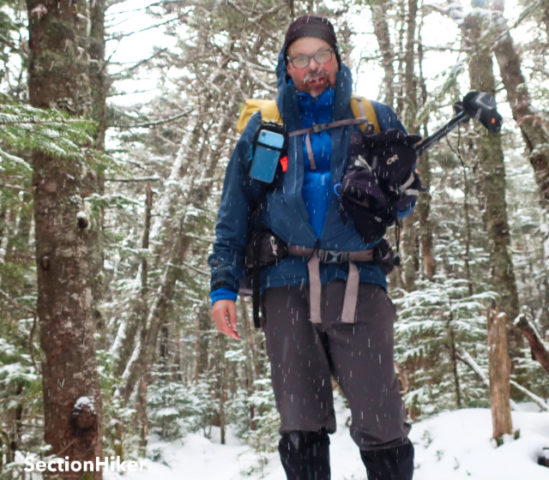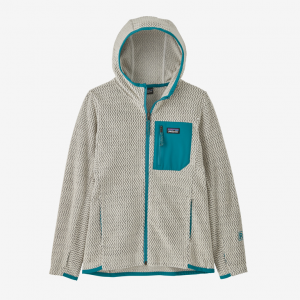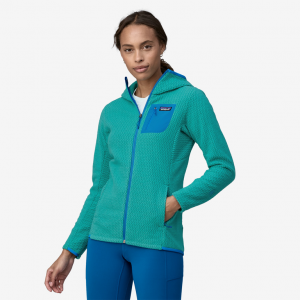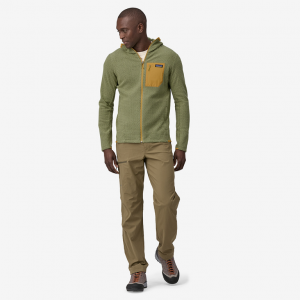
The Patagonia R1 Air Full-Zip Hoodie is a warm mid-layer fleece that’s ideal for use in very cold weather when worn by itself over a baselayer or under a hardshell jacket. It’s made with recycled polyester fleece and has a unique textured weave that is surprisingly lightweight. While Patagonia classifies it as a lightweight (R1) fleece, it is much warmer than Patagonia’s iconic R1 Hoodie or the R1 Pullover and you’d swear it was made with a thicker, more insulating fleece fabric.
Specs at a Glance
- Gender: Men’s and Women’s models available
- Weight: 13.5 oz in a Men’s XL
- Pockets: 5 (1 chest, 2 handwarmer pockets, 2 interior drop pockets)
- Length: Hip length
- Thumb Loops: No
- Hood: Yes
- Fit: true to size in a men’s XL.
The Patagonia R1 Air Full-Zip Hoodie is a cool-looking fleece hoodie with a grooved zigzag weave designed to wick perspiration and enhance breathability. It’s made using hollow fiber yarns which trap air providing enhanced warmth and a very soft feel. The recessed indentations in the zigzag pattern enhance breathability, while the embossed raised portion of the pattern provides added warmth, much like the Polartec PowerGrid fleece used on the R1 Hoodie and Pullover.

But the Patagonia R1 Air Full-Zip Hoodie is noticeably warmer than the PowerGrid fleece used on those other R1 garments. How much warmer? While it’s cozy when you’re sitting around the cabin on a snowy day or running out to the post office, it feels like you’re wearing a much heavier-weight fleece when you crank up the activity level. I think its sweet spot for winter hiking and mountaineering is 10F degrees or less when worn under a hardshell jacket. Much warmer than that and I start to overheat and perspire too much and have to take it off. But for colder winter conditions, it’s a superb mid-layer insulation piece that is very lightweight and wicks moisture out of your base layer.
Patagonia R1 Air Full-Zip Hoodie
Warmth
Weight
Compressibility
Moisture Resistence
Features
Comfort
Features
Feature-wise, the R1 Air Full-Zip Hoodie is a bit less technical than I’d prefer in a cold-weather hoodie. It has a close-fitting (non-stretch) hood that can fit under a helmet or inside a hood without much excess volume. There is a zippered chest pocket, two zippered handwarmer pockets, and two deep internal drop pockets. However, the chest pocket is not large enough to fit a smartphone, which is a head-scratcher, and the side handwarmer pockets are not hip-belt compatible. In addition, the sleeves do not have thumb loops or any kind of stretch cuff to seal out the wind.

Recommendation
Personally, I can live with all of these feature shortcomings, even the too-small chest pocket, given the incredible warmth provided by the hoodie. It’s hard to find fleece mid-layers that are this warm and this lightweight. Given the thermal and wicking properties of fleece, I prefer wearing it instead of a synthetic or down-insulated jacket under a hardshell in cold conditions because it is so effective at moving moisture out of my base layer and evaporating it. If you run cold when winter hiking, or any snowsport, and want a warm mid-layer that won’t weigh you down, give the Patagonia R1 Air Full-Zip Hoodie a shot. You won’t ever want to take it off!
Disclosure: The author purchased this product.
Updated October 2022.
Compare 6 Prices
-

 Amazon USUsed $32.61
Amazon USUsed $32.61$60.00$34.97ViewAmazon.com Price: $34.97 (as of 04/23/2024 03:35 GMT-0400) Details
Product prices and availability are accurate as of the date/time indicated and are subject to change. Any price and availability information displayed on Amazon.com at the time of purchase will apply to the purchase of this product.
-

 Backcountry.com
Backcountry.com$159.00$72.51View -
 REI$119.00View
REI$119.00View -

 Patagonia$119.00View
Patagonia$119.00View -
 REI$179.00View
REI$179.00View -

 Patagonia$179.00View
Patagonia$179.00View -

 Patagonia$179.00View
Patagonia$179.00View
 SectionHiker.com Backpacking Gear Reviews and FAQs
SectionHiker.com Backpacking Gear Reviews and FAQs 

I have one and can testify to the warmth. But I cannot wear it for anything other than running errands. I purchased it for the winter to breaking trail and man does it wet out for me. After waking up the next morning and stowing it between my down bag and synthetic bag to dry I still had some moisture in the fabric. At least that is one way to get ya motivated in the morning to get moving after breakfast. Luv it other wise and a great company. And is it me or is everything getting expensive?
Not sure I’d use the term “wet out” for a fleece, but yeah, you have to take it off if you sense yourself perspiring heavily. I can only wear it for active use (like climbing elevation) if it is pretty darn cold and unpleasant out. Otherwise, it’s just too warm. That’s not necessarily a bad thing but it makes it harder to layer with than a bunch of cooler layers. I do think it would be a good piece for people who do a lot of start and stop activity like downhill skiers – up the chairlift n their buts and then flying downhill and working up some warmth or for winter hikers who always feel very cold. Patagucci has always been expensive, but a lot of gear has gotten more expensive across the board.
You don’t specifically say this could serve the same role as a puffy jacket for a hiker–could you see a backpacker using this instead of a down puffy? I’ve been casting my eye around for a replacement for my down puffy jacket, initially by looking at puffy synthetics (like maybe OR’s SuperStrand LT Hoodie) and wonder if this could be a candidate….
Keep up the good work, you’re turning into a mini media empire ;)
Fleece is really an active mid-layer (whose primary benefit is wickability) not a passive one like a puffy. I might just be a curmudgeon, but I just don’t get using a puffy as a midlayer. It makes no sense to me because the moisture doesn’t escape, it just gets stuck inside the insulation. Fleece rocks. Plain old 100 weight is still the best, although I have a growing appreciation for vests in winter as well.
BTW – I am now carrying the Superstrand LT on winter hikes as my puffy, as least on non-life threatening peaks. The thing is WARM.
Sounds like you’re saying “not good for wearing while in camp like a puffy” which is what I use a puffy for 98% of the time while on trail. Tx.,
PS agree on fleece vests, though I typically don’t carry both a vest and a regular fleece top when backpacking. I also don’t backpack in the winter, though…
Sorry if that wasn’t clear. The R1 doesn’t replace a puffy.
I have one of the older PowerGrid R1 Hoodies and I have to say it’s the best piece of equipment I own. I look forward to weather cool enough to start wearing it. It’s warm, stays dry, and it’s super comfortable. Sounds like the newer models are a bit different experience but I absolutely LOVE my R1. As part of a system including a base, the R1 and a wind shirt or jacket, it’s unbeatable for hiking. It may take time to dial-in how to utilize the newer one but it’s a great piece of gear!
How would this compare to alpha direct 90/120 layers?
Alpha is lighter and many boast about its warmth. Yes, alpha doesn’t protect from wind at all, but with hard shell would be a lightweight combo.
It’s really kind of impossible to compare insulations in the absence of a garment and how the insulation is used in it. Alpha can be used in many different ways in direct contact with the skin or encased in fabric layers. But like CoffeeBru above, I frequently just layer a wind jacket over a fleece, or even just a wind vest, and I’m comfortable all day.
Are you familiar with Patagonia’s old R3? Would you compare it to that? I have an R3 and it is quite warm.
I’ve used 300 weight fleece before, not Patagonia, but EMS, and it was warmer than the R1 Air and heavier.
I love the R1, original and Air, but there is absolutely no way that I would recommend this as the main warmth layer for winter hiking. It is nowhere near as warm as even a nanopuff, let alone even a light weight puffy. For the second layer in a 4 layer system, base layer, R1, puffy or similar, rain shell as needed, it is great. By itself with just base layer and rain shell it is a formula for hypothermia in any real winter situation.
We’ll have to disagree. I always hike in winter in a 3 layer system – base layer, fleece, shell or wind shirt. The puffy only goes on top when we stop.
Phillip, Years ago, I bought a Similar Fleece Garment to use on a Hike into the Eastern Sierras in early September. I had a Gore-Tex Shell over the top of it and a Smart Wool Sweater and ECWS Long Underwear under it. That night the Temperature Dropped quickly to 30 degrees in no time at all on a star lit clear night….. I was cold, very cold, and started shivering.. So please tell me at what Temperature you tested this out at… Thanks.
Between -10 and 30 degrees. Mind you, I was climbing mountains in snow, wind, and as you can see blowing snow, not sitting around camping. If you’re going to be sitting around, get yourself a down or synthetic parka and insulated pants. Fleeces, like the R1 Air, work best for active use because they’re highly breathable, meaning they’re designed to make your perspiration evaporate.
Thanks Phillip… I see the Manufacturers have changed their advertising for just what to use the Fleece for… I was wearing it after making the 5-mile climb from Lake Sabrina to Blue Lake and a gain of a couple of thousand feet and was sitting around resting after that long climb… I did buy a 850 Goose Down Parka after that as well as a Goose Down Vest and have never been cold since, especially being on Blood Thinners… Thanks for responding.
Nice review.
It covers most of what I experienced with the non-hooded version of this shirt I got this season. The fabric is indeed quite high-tech. The chest pocket barely holds my old, tiny iPhone SE v1. Having a built-in chest pocket is critical for me to keep my phone accessible and warm for photos and GPS.
I have the non-hooded half-zip, which has no hand pockets. It weighs around 12 ounces on a scale in XL, if memory is correct. It will be interesting to see how it stacks up to my 9 ounce Polartec Classic half zip after a lot of use.
I’m a real fan of the original R1….I thought it would be too warm to backpack in, but when temps were in the upper 30s on an overnighter recently, it worked perfectly under my 30 lb pack (also a thanks to the close fit and long chest zipper to cool down). Maybe I’ll give this Air version a try. And as an aside, your weekly newsletter is paramount in providing information….not only the articles, but the comments by the readers as well!
The readers have a lot of expertise that I know I benefit from as well. What is a website without reader interaction (comments)?
interesting piece of cold weather clothing. A very thorough review. Thanks Philip.
Is appears both the hollow fibers (like deers” hair) and the zig-zag pattern contribute to the good warmth-to-weight ratio. Great for XC skiing or snowshoeing on a 10F. day WITH a windbreaker parka.